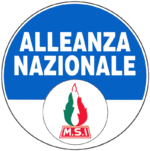
Back Alleanza Nazionale Catalan Alleanza Nazionale Danish Alleanza Nazionale German Εθνική Συμμαχία (Ιταλία) Greek National Alliance (Italy) English Nacia Alianco Esperanto Alianza Nacional (Italia) Spanish Alleanza Nazionale Finnish Nemzeti Szövetség Hungarian Ítalska þjóðarbandalagið Icelandic
| Alliance nationale Alleanza nazionale | ||||||||
 Logotype officiel. | ||||||||
| Présentation | ||||||||
|---|---|---|---|---|---|---|---|---|
| Président | Gianfranco Fini (1995-2008) Ignazio La Russa (2008-2009) |
|||||||
| Fondation | ||||||||
| Disparition | ||||||||
| Fusionné dans | Le Peuple de la liberté | |||||||
| Journal | Secolo d'Italia | |||||||
| Positionnement | Droite[1] à extrême droite | |||||||
| Idéologie | Conservatisme social[2] National-conservatisme[3] Post-fascisme[4] |
|||||||
| Affiliation nationale | Pôle du Bon Gouvernement (1994) Pôle pour les libertés (1996-2001) Maison des Libertés (2001-2008) |
|||||||
| Affiliation européenne | Alliance pour l'Europe des nations | |||||||
| Groupe au Parlement européen | Union pour l'Europe des nations | |||||||
| Adhérents | 250 000 (2004)[5] | |||||||
| Site web | www.alleanzanazionale.it | |||||||
| ||||||||
Alliance nationale (en italien : Alleanza nazionale, abrégée en AN[6]) était un parti politique italien d'extrême droite. Créé en 1995, héritier du Mouvement social italien, il se dissout le dans Le Peuple de la liberté, dont il devient, un temps, une composante fondatrice. En juillet 2010, une scission de ce nouveau parti se produit, menée par d’anciens d’AN, suivant Gianfranco Fini, en conflit avec Silvio Berlusconi (le groupe parlementaire puis parti politique Futur et liberté pour l’Italie).
- Carlo Ruzza et Stefano Fella, Re-inventing the Italian Right : Territorial Politics, Populism and 'post-fascism', Routledge, , 272 p. (ISBN 978-0-415-34461-6, lire en ligne), p. 1
- ↑ Miroslav Mareš, Transnational Networks of Extreme Right Parties in East Central Europe : Stimuli and Limits of Cross-Border Cooperation, (lire en ligne [archive du ]), p. 4
- ↑ Marco Tarchi, Recalcitrant Allies: The Conflicting Foreign Policy Agenda of the Alleanza Nazionale and the Lega Nord, Ashgate, , p. 188
- ↑ Patrizia Catellani, Patrizia Milesi et Alberto Crescentini, Extreme Right Activists in Europe: Through the Magnifying Glass, Routledge, (lire en ligne), « One Root, Different Branches: Identity, Injustice and Schisms », p. 18 :
« Yet this is not to say that the fascist heritage in the new 'post-fascist' AN faded altogether. At least at the beginning, Fini had a double standard of communication, one for inside the party, stressing continuity with fascism, one for outside the party, stressing change. »
- ↑ « Archived copy » [archive du ] (consulté le )
- ↑ Ou An, selon la typographie usuelle italienne.